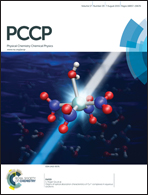Proton transport in barium stannate: classical, semi-classical and quantum regimes
Abstract
Density-functional theory calculations are performed to investigate proton transport in BaSnO3. Structural optimizations in the stable and saddle point configurations for transfer (hopping) and reorientation allow description of the high-temperature classical and semi-classical regimes, in which diffusion occurs by over-barrier motion. At lower temperature (typically below 300 K), we describe the thermally-assisted quantum regime, in which protonic motion is of quantum nature and occurs in “coincidence” configurations favored by thermal fluctuations of the surrounding atoms. Both the non-adiabatic and the adiabatic limits are examined. In the adiabatic limit, the protonic energy landscape in the coincidence configuration is very flat. Path-integral molecular dynamics simulations of the proton in the coincidence potential reveal, in the transfer case, that the density of probability of H+ has its maximum at the saddle point, because the zero-point energy exceeds the coincidence barrier. Arguments are given that support the adiabatic picture for the transfer mechanism. In the case of reorientation, the time scales for the existence of the coincidence and for protonic motion, as estimated from the time-energy uncertainty principle by using a simple one-dimensional model, are of the same order of magnitude, suggesting that the adiabatic limit is not reached. Protonic transfer and reorientation in this oxide are therefore governed by different mechanisms below room temperature.


 Please wait while we load your content...
Please wait while we load your content...